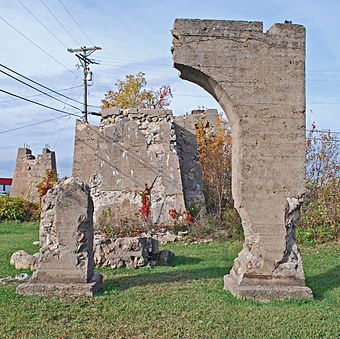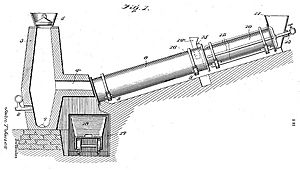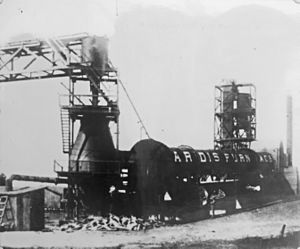Ardis Furnace facts for kids
Quick facts for kids |
|
|
Ardis Furnace
|
|
 |
|
| Location | Aragon and Antoine Sts., Iron Mountain, Michigan |
|---|---|
| Area | less than one acre |
| Built | 1908 |
| Architect | John T. Jones |
| NRHP reference No. | 72000608 |
| Added to NRHP | June 29, 1972 |
The Ardis Furnace is an old, experimental machine found in Iron Mountain, Michigan. It was a special type of blast furnace, which is used to make iron. This furnace was named a Michigan State Historic Site in 1971. A year later, it was added to the National Register of Historic Places. You can find its remains at Aragon and Antoine Streets.
Contents
What is the Ardis Furnace?
The Ardis Furnace was built as a huge metal tube. It was about 120 feet long and 8 feet wide. Inside, it had a special lining made of firebrick. The tube was placed on a slight slope.
Electric motors helped rotate this large tube. The goal was to collect refined iron at the lower end. Today, only the concrete supports that held the tube remain. The rest of the furnace has fallen apart.
The History of the Ardis Furnace
In 1908, a man named John T. Jones lived in Iron Mountain. He built this experimental furnace. He wanted to test a new way to get iron from low-quality ore. Ore is rock that contains metal.
Jones named the furnace "Ardis" after his daughter. He hoped it would make purer iron. He also thought it would use less fuel than other methods. His ideas were described in his 1908 patent. A patent is a special document that protects an invention.
At first, the Ardis Furnace seemed like a big success. Jones even turned down offers of millions of dollars for his patent. More furnaces were built in other Michigan towns. People believed that refining ore right where it was found would save a lot of money on shipping.
Why the Furnace Failed
After a while, problems started to appear. The firebrick lining inside the iron tube could not handle the extreme heat. Jones hired engineers to help. They made some improvements. However, the main problem with the heat was never solved.
Jones put more and more of his own money into the project. Within two years, he had spent all his money. He lost everything, even his house. The furnace was taken apart and sold for scrap metal. The project was given up.
Even though the Ardis Furnace didn't work out, Jones kept working. He became a consultant for other mining projects. Some parts of his technology were later used in successful ways. These new methods helped get iron from low-quality ore.
Saving the Furnace Remains
In the early 1970s, there were plans to tear down what was left of the Ardis Furnace. But a local group, the Menominee Range Historical Foundation, wanted to save it. They asked for help.
The Hanna Mining Company bought the remains of the furnace. They then gave it to the Foundation. In 1972, the Ardis Furnace was officially added to the National Register of Historic Places. This helped protect it as an important historical site.
Who was John T. Jones?
John Tyler Jones was born in Pittsburgh, Pennsylvania, in 1847. His parents were immigrants from Wales. When he was 13, Jones started working with his father. He quickly became a skilled mechanic. He also learned how to operate engines.
In 1870, Jones moved to Sharon, Pennsylvania. He set up and ran a furnace there for ten years. During this time, good quality iron ore was becoming harder to find. Jones began to experiment with different ways to get iron. He taught himself chemistry along the way.
Jones married Rachel Ann Milligan. They had nine children together. In 1881, Jones moved to Michigan's Upper Peninsula. He managed mines there for a company. In 1883, he moved to Iron Mountain.
He later started the Hamilton mine. He also explored for minerals in South America. Jones worked in other mines across the country. His many projects made him a very rich man. He built a large, beautiful home on a big piece of land. It was on the shore of Lake Antoine in Iron Mountain.
His house had many modern features. One interesting part was a huge greenhouse attached to it. This greenhouse was made from parts of the Ferris wheel from the 1893 Chicago World's Fair.
After losing his money with the Ardis Furnace, Jones moved in with his son. He continued to work as a mining consultant. John T. Jones passed away in 1928. He was visiting his sister in Pennsylvania at the time.
Images for kids













